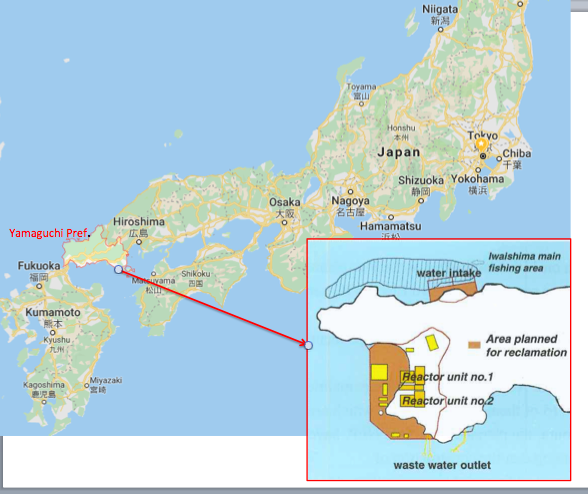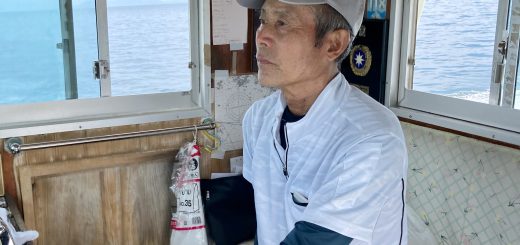Update on Kaminoseki Nuclear Power Plant Project

Kaminoseki NPP
The Kaminoseki Nuclear Power Plant Project, long stagnating in Yamaguchi Prefecture, is facing a major turning point. Chugoku Electric Power Company, the proposer of the project, plans to build two nuclear reactors in a narrow seaside area. One part of the major plant facilities is designed to be built on reclaimed land. Such a construction is unprecedented in this country.
To reclaim the sea area, the power company is required to have a valid public water reclamation permit issued by the Yamaguchi Prefectural Government. The most recent permit the company obtained was in 2016; that permit expired in July this year. On June 10, 2019, prior to the expiry, Chugoku Electric applied for postponement of the expiry. How the Yamaguchi Prefectural Government will process the application is attracting public attention.
What is the Kaminoseki Nuclear Power Plant Project?
The Kaminoseki NPP Project was proposed by Chugoku Electric, which plans to build two advanced boiling water reactors (ABWRs) with an output capacity of 1,370,000 kW each on Nagashima Island, Kaminoseki Town, Kumage District, Yamaguchi Prefecture.
The plan to build the NPP first surfaced in 1982. The local municipality of Kaminoseki Town invited Chugoku Electric to implement the project. However, the Fisheries Cooperative of Iwaishima Island, which is located immediately across from the planned NPP site, adopted a resolution in 1983 opposing the project. Sturdy resistance by the cooperative and islanders has been keeping the project on hold.
In 1999, Chugoku Electric submitted an environmental assessment report to the Agency of Natural Resources and Energy. In the following year, the Agency instructed the company to conduct an additional assessment. Following these events, a citizens’ conservation group, the Association for the Preservation of Nagashima’s Nature (headed by Takashima Midori), found that Japanese murrelets, designated an extinct species, inhabited the area. The area was also found to be home to a rare shellfish, Yashimaishin. Thus environmental assessment by citizens has been making steady progress.
On the north side of the planned NPP site lies the Shidai Sho-hachimangu Shrine, whose former chief priest was against the sale of the land in the vicinity to Chugoku Electric. In 2003, the Association of Shinto Shrines, the National Body which supervises the shrine, dismissed the priest, enabling the sale of the land to the company to go ahead.
After these events, in 2008, Chugoku Electric applied to the Yamaguchi Prefectural Government for a public water reclamation permit, which it successfully obtained. In the next year, the company applied to the Minister of Economy, Trade and Industry (METI) for a permit to build one of the planned reactors. The Nuclear and Industrial Safety Agency, a division of the METI at that time, held about five application review meetings, and in 2010, the Agency requested Chugoku Electric to perform an additional geological survey. On the other hand, the company attempted to start reclamation work in the shore area in 2009 but was stopped by strong resistance. Later, in early 2011, the company attempted to resume the survey but was again pushed back by strong resistance. This was shortly before the March 12 explosion at the Fukushima Daiichi Nuclear Power Station. After the explosion, then Governor of Yamaguchi Prefecture Sekinari Nii requested the company to postpone the construction work. Chugoku Electric accepted the request and reclamation work has been on hold since then.
Developments in the treatment of the public water reclamation permit
The 2008 sea reclamation permit was issued with a three-year validity. In 2012, Chugoku Electric requested the Yamaguchi Prefectural Government to extend the validity of the permit, which was approved in 2016. The reason why it took four years to have the 2012 application approved was that the Fukushima Daiichi NPS disaster brought about significant changes in national nuclear policy. When the Fukushima disaster occurred, the Democratic Party of Japan was in power and had a policy of not approving new nuclear plants. The Yamaguchi Prefectural Government and Chugoku Electric exchanged communications seven times to evaluate the necessity of a new NPP plant and the realizability of the project. Mr. Nii, the then Governor, was clear that Yamaguchi Prefecture would not approve the extension of the permit, and his policy was continued by Shigetaro Yamamoto, who was elected as Governor in July 2012. In December 2012, however, the Democratic Party stepped down and the public consensus, regarding no more new plants, was also torn down.
Chugoku Electric is dependent on the 2005 cabinet resolution that the Kaminoseki project was an “important electric power development site.” This designation was based on the Electric Power Development Promotion Act by the Electric Power Development Coordination Council, both of which had been abolished in the previous year. That is, the cabinet confirmed that, despite the abolition of the Act and Council, the designation of the Kaminoseki site as an important electric power development site was still valid. Chugoku Electric requested Mr. Yasunaga, then Manager of the Electricity Infrastructure Division of the Agency, to write a statement confirming that the cabinet resolution was still valid and would not be overturned “without circumstantial change.” Mr. Yasunaga prepared the statement as requested and handed it to Chugoku Electric. Presenting this statement, Chugoku Electric confirmed the realizability of the NPP construction to Yamaguchi Prefectural Government. Yamaguchi Governor Muraoka, successor to Governor Yamamoto, agreed with the extension of the permit, but requested the company in writing not to perform reclamation work unless the start of the construction of the power plant itself became foreseeable. Chugoku Electric accepted this condition. The situation concerning the permit has not changed since then.
The issue of the “circumstantial change” has been discussed at the national assembly, but the Japanese government is nonchalant about the issue, stating that there has been no circumstantial change, even after the Fukushima Daiichi disaster. On June 7, 2019, the NO to Nukes at Kaminoseki YES to Seto Inland Sea Nature Conservation Citizen’s Network, in which Citizens’ Nuclear Information Center participates, and the Group of Plaintiffs against Kaminoseki Nuclear Power Plant Site Land Reclamation, which is active in and around Yamaguchi Prefecture, had a meeting with METI to clarify what would correspond to a “circumstantial change.” According to replies from the ministry, if Chugoku Electric withdrew the NPP construction plan, or if the hosting municipality (Yamaguchi Prefecture) decides to oppose the plan, it would be a “circumstantial change.” So, Chugoku Electric requests the extension of the permit because the METI’s designation of the Kaminoseki site as an “important electric power development site” is valid, while METI says that the designation is valid because Chugoku Electric has not withdrawn the construction plan. METI also says that the site designation does not mean that the NPP construction is mandatory and that it is up to the power company to decide whether or not to build the NPP. The June 7 meeting clarified that both the company and METI are irresponsible, each using the other’s reasoning as the basis of the validity of the designation of the Kaminoseki site as an “important electric power development site.”
Difficulties in the construction of a nuclear power plant
The application submitted on June 10 by Chugoku Electric to the Yamaguchi Prefectural Government requests an extension of the validity of the reclamation permit to January 6, 2023. During the upcoming three years and six months, however, it is unlikely that the start of the construction of the NPP will become foreseeable. The reason is that, to initiate the construction of a nuclear power plant, the company must pass the safety assessment imposed by the Nuclear Regulation Authority (NRA). The NRA considers that it cannot begin a safety assessment unless Chugoku Electric applies for permission to alter the NPP installation such that it indicates compliance with the New Regulation Standards. The construction application based on the former regulations is no longer valid. Chugoku Electric places priority on obtaining governmental approval to start commercial operation of the NPP plant it owns, namely, Shimane Units 2 and 3, over the Kaminoseki Project. Concerning the Kaminoseki project, in addition to the geological survey at the planned site, issues concerning earthquake resistance must be reassessed; active faults in the vicinity need to be reexamined and reassessed. There is also the issue of volcanoes. Under these circumstances, the Kaminoseki NPP construction permit is unlikely to be issued within the three-year-and-six-month period. The NRA is also not ready to process an application for a new NPP, because the construction of new nuclear plants is not called for under the national Strategic Energy Plan.
Chugoku Electric submitted a power supply plan (up to 2028) to the Organization of Cross-regional Coordination of Transmission Operators, Japan (OCCTO), but the plan does not include power supply from the Kaminoseki Plant. The Chugoku Electric management plan shows that both the start of construction and commercial operation of the Kaminoseki Plant are unknown. It indicates that Chugoku Electric itself does not consider that it can start construction of the Kaminoseki plant in or before 2023.
While energy-saving efforts are making steady progress in Japan after the 2011 Fukushima Daiichi disaster, Chugoku Electric’s maximum power demand decreased from 12,000,000 kW in 2011 to 10,500,000 kW in 2018. The company estimates that its power demand will remain at around this level for the next ten years. When Shimane Units 2 and 3 start commercial operation, power supply will exceed demand. For Chugoku Electric, the Kaminoseki Nuclear Power Plant is no longer necessary.
The cost of building a new nuclear power plant will be significantly higher than before (although the company’s cost estimation is unknown), and it is not likely that the company will recover the cost during the years of the commercial operation of the plant.
An increasing number of municipalities near the planned Kaminoseki site are turning against the project. The Fisheries Cooperative of Iwaishima and citizen groups are also strongly opposed to the project, and in June this year, signatures of people who are against the extension of the reclamation permit were submitted to the Yamaguchi Prefectural Government.
Under these circumstances, Chugoku Electric should withdraw the permit extension application and shift its stance toward a cancellation of the project. This is also reasonable in terms of its business management. The Yamaguchi Prefectural Government should not extend the reclamation permit but should encourage the company to cancel the project. The key point is that, if a major accident occurs, Chugoku Electric will go bankrupt and Yamaguchi Prefecture will be devastated.

